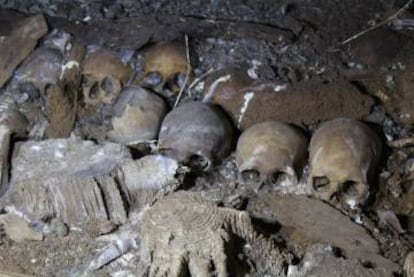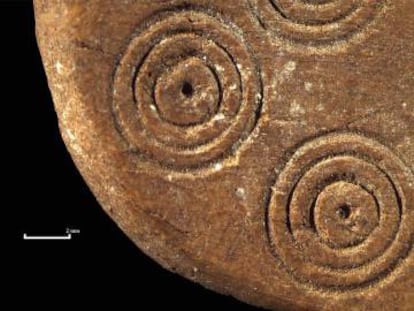Menorca’s mysterious trepanned dead
A newly discovered cave conceals 3,300-year-old human remains with holes in their skulls


The archaeologist Eva Alarcón remembers the day she entered the Biniadrís cave for the first time – a forgotten cavern in the rock that hadn’t been touched for thousands of years. “It made me shiver,” she recalls. Alarcón had been perched on the wall of a cliff, 16 meters up in the summer of 2015. There, in an almost inaccessible hole in the rock face, measuring just 10 square meters, were a great number of human skulls covered with dirt. Some had a perfect orifice drilled into the cranium, indicating that they had been trepanned. “It’s exciting to think you’re in a place where time has stopped for 3,000 years,” she says.

Alarcón is the co-director of the archaeological dig at Biniadrís, a cave that was discovered in 2013 in the island of Menorca in the Balearic Islands. So far, her team has identified the bones of around 100 people belonging to the island’s Talayotic period during the Bronze Age. The cave, she explains, was used from around 3,300 years ago until around 2,600 years ago as a burial site – “a sacred space” where mysterious funeral rituals were carried out.
“We don’t know how they got the bodies to the cave,” she says. “It appears that they wrapped them in a kind of linen shroud and carried them on their backs. They placed the body in the center of the cave, covered it with red ocher and left it there until they had to make room for another body. Then they would pile the old remains up against the sides of the cave.”
Archaeologist Eva Alarcón felt “shivers” entering the cave filled with perforated skulls
Alarcón, who works out of Granada University and whose team has just published the first results of their research in the magazine Quaternary International, has photos of one of the most impressive discoveries in Biniadrís: a perfectly preserved lock of hair dyed with red ocher powder. “They cut a lock of hair from the dead and placed it in a tube that was made of leather or wood or other materials,” she explains. In the lids of these tubes, which were made of bones, they carved a series of almost perfect concentric circles. It’s impossible to know what these ceremonies meant to them. In the same period, the Assyrians worshiped Enki, the god of fresh water; and the Egyptians worshiped Osiris, god of the afterlife. Like thousands of other beliefs that prompted generations of wars, they no longer mean anything.

Archaeologists have also discovered buttons made of bone in the cave, similar to those from a duffel coat that suggest that the bodies were dressed. “The buttons were pieces of craftsmanship that were perhaps passed down from generation to generation,” says archaeologist Manuel Altamirano, also from Granada University.
In their report, Alarcón’s team describes five trepanned skulls bearing practically perfect holes. Some of these holes are scarcely big enough to fit a pencil through while others are as big as three centimeters in diameter. The lips of the holes suggest that the bone regenerated after the operation and the individuals subjected to the surgery carried on living. “Trepanation was a common medical operation dating back to Neolithic times, undertaken to relieve the pressure of meningitis, or strong headaches,” explains the archaeologist Marta Díaz-Zorita from Tubinga University in Germany, who is carrying out the anthropological research on the Biniadrís’s remains. “The trepanations were performed by people with a certain know-how,” she says. “They made the holes with a stone tool using it like sandpaper and then employed a point. They would have had some kind of painkiller to avoid the pain.”
The Biniadrís cave is the last mysterious corner of the funeral territory known as the Cales coves in the Alaior region of Menorca where, in 1990, other caves were found containing evidence of similar burials, such as Es Mussol, Es Càrritx and Es Pas. But, even within this extraordinary framework, Biniadrís is “exceptional” due to the quality of the remains, according to Díaz-Zorita. Financed by the Rubió i Tudurí Foundation and Consell Insular, the digs will continue next summer – the cave still has much to reveal about the trepanned redheads.
World Heritage?
The Biniadrís cave is the last jewel from Talayotic Menorca, a culture present in more than 1,500 sites across the island, according to data from the Insular council. Recently, the Insular council proposed a selection of these archaeological sites for UNESCO’s World Heritage list. However, after a recommendation from the International Council on Monuments and Sites to reshape the proposal, the Insular council announced it would be postponing the candidacy in May. The report recognized the potential of Talayotic Menorca, but pointed out that certain things were lacking such as paintings and vegetation at some of the sites.
English version by Heather Galloway
Tu suscripción se está usando en otro dispositivo
¿Quieres añadir otro usuario a tu suscripción?
Si continúas leyendo en este dispositivo, no se podrá leer en el otro.
FlechaTu suscripción se está usando en otro dispositivo y solo puedes acceder a EL PAÍS desde un dispositivo a la vez.
Si quieres compartir tu cuenta, cambia tu suscripción a la modalidad Premium, así podrás añadir otro usuario. Cada uno accederá con su propia cuenta de email, lo que os permitirá personalizar vuestra experiencia en EL PAÍS.
¿Tienes una suscripción de empresa? Accede aquí para contratar más cuentas.
En el caso de no saber quién está usando tu cuenta, te recomendamos cambiar tu contraseña aquí.
Si decides continuar compartiendo tu cuenta, este mensaje se mostrará en tu dispositivo y en el de la otra persona que está usando tu cuenta de forma indefinida, afectando a tu experiencia de lectura. Puedes consultar aquí los términos y condiciones de la suscripción digital.
More information
Archived In
Últimas noticias
Most viewed
- Why we lost the habit of sleeping in two segments and how that changed our sense of time
- Charles Dubouloz, mountaineering star, retires at 36 with a farewell tour inspired by Walter Bonatti
- Venezuela faces its most tense Christmas yet
- CBS in crisis after pulling a report on Trump’s deportations to El Salvador (which later leaked online)
- Bukele clan fumes over investigation exposing their new wealth










































